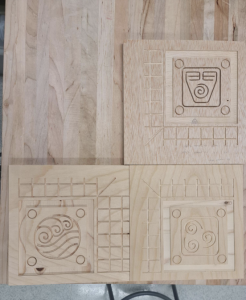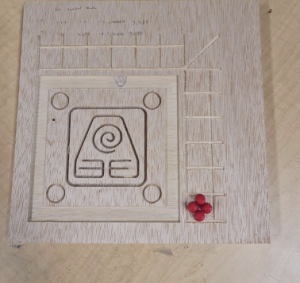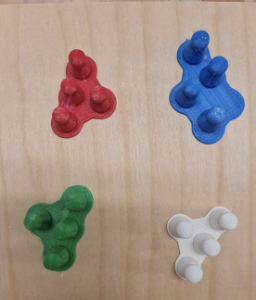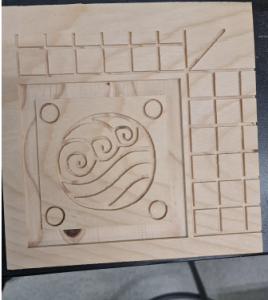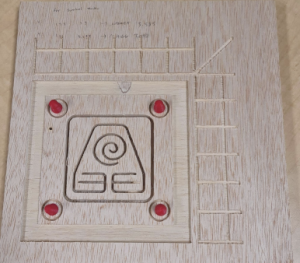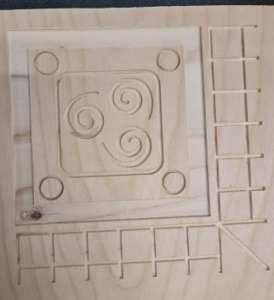Students:
Alastair Cho ’24 Arin Mukherjee ’24 Maaz Khatri ’23. William Ezratti ’23


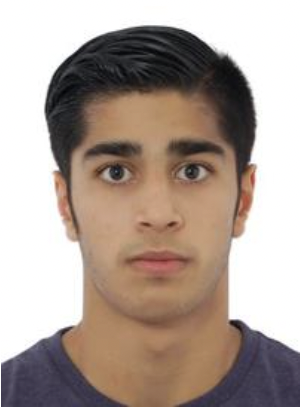

Description:
Our final project involved the making of a wooden Ludo board game set. During our planning stage, we decided that we would use the wood-carving machine (Carvey by Inventables) to create the board, and use a 3D printer for the game pieces. The dimensions of the wooden board would consist of 4 individual pieces of 8’’ x 8’’ x 0.5’’plywood that could be combined together to create the complete game board.
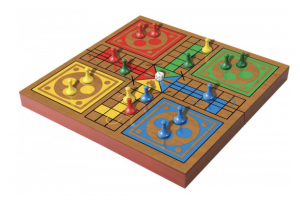
During the first weeks, we finalized our carving designs using the Easel software and carved this practice design into a piece of plywood to ensure our design was successful in its application from the software. As you can see from the picture on the right, we started off with a simple design to ensure the accuracy of the ‘Carvey’ and to aid our learning process on the easel software.

After gaining a more cohesive understanding of the easel software, we were able to do more complex designs and learned how to import pictures from the internet onto the software. As a result, we decided to make our Ludo board in an “Avatar: The Last Airbender” theme as we would be able to import the different nation designs from the internet to our software and craft a more aesthetically pleasing game board.
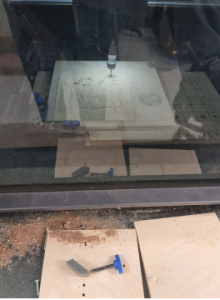
Working with the Carvey came with its own set of difficulties. For example, when we first started, we had a problem with determining the depth that the Carvey would carve and had to continuously change the height of the clamps to match this. Furthermore, during our initial cut, the depth of our Carvey was calibrated incorrectly, causing the drill to cut too deeply, which burned a hole in the wood (seen closest to the red pawn in the top right). We had to do some further adjustments to correctly align the Carvey to where we wanted it to go.
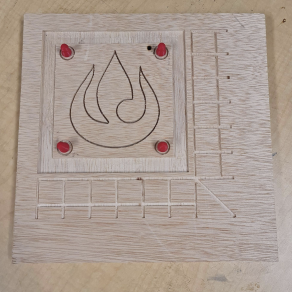
After finalizing our “Avatar” designs and mastering the Carvey and easel software, we turned our attention to the 3D printer in order to create our game pieces. Collectively, we looked at many different online designs and settled on a basic chess pawn. The four nations in Avatar represent the four elements (fire, water, earth, and air), so we planned to print our pieces using 4 different color filaments: red, blue, green, and white. Initially, we faced some difficulty as our first set of game pieces turned out to be too small and did not fit the game piece slots on our board. Therefore, we carefully measured the dimensions on the wooden board and applied it to the 3D printing software to create a more accurate size as shown in the picture. As soon as we were able to get the dimensions correct, we quickly were able to assemble all the game pieces we needed as shown in the picture.
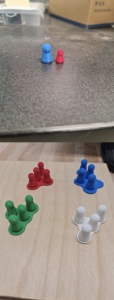
Together, with the game pieces and the wooden board, our project will be completed. However, we had some stretch goals that we would have liked to achieve if we had any additional time. One goal is to create wooden pawn pieces as opposed to the 3D printed plastic pieces as it gives a more complete look to the board game. We also wanted to create a folding mechanism using hinges to connect the four different quarters of the wooden board together, but there were time constraints attached to this task that made it difficult to finish before the deadline.
We successfully completed three of the four boards, but because each board took approximately an hour to carve, we were forced to wait until a few days after Dean’s Date to return to the shop to carve our final board piece.
Within our team, Alastair and Arin took the lead in creating the carvable design using the Inventables software, Maaz took the lead in carving the wood using the designs as a model, and Willy assisted in printing the pawn pieces.
